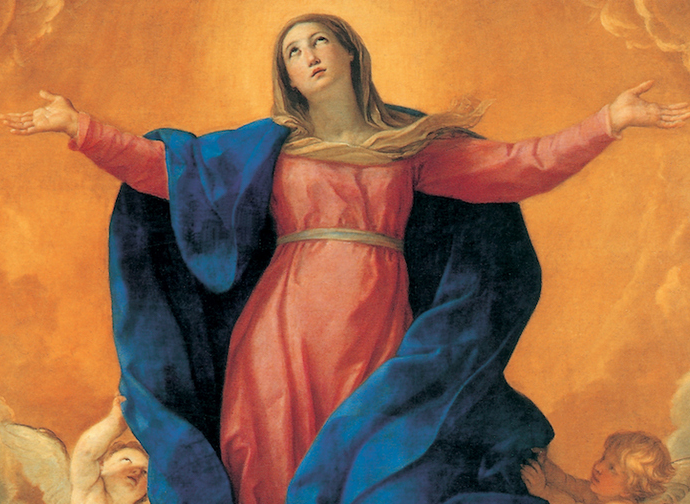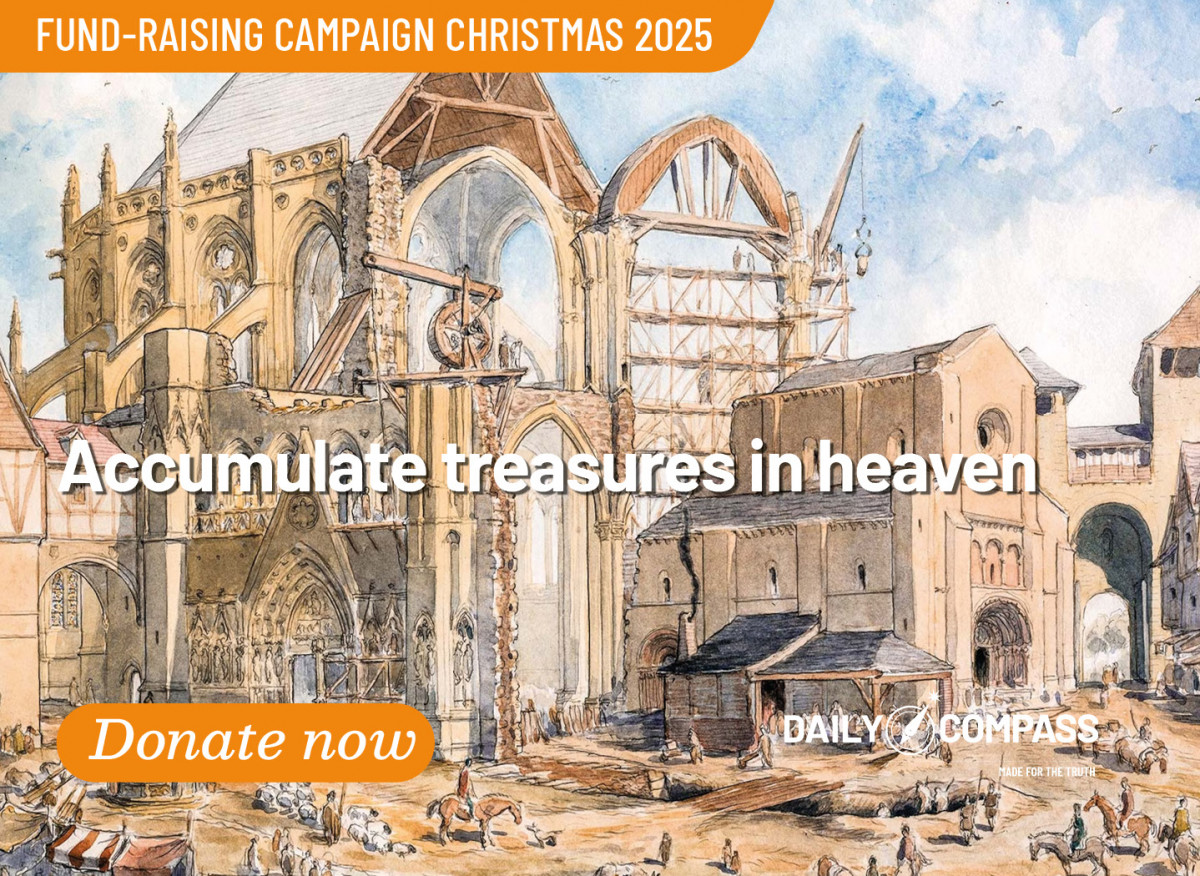Our Lady of the Assumption is the new and definitive Ark of the Covenant
In the Old Testament, we learn that the Ark of the Covenant was removed from the Temple and hidden by Jeremiah on Mount Zion on God's orders. According to a precise divine plan, it was never found again because it was the precursor to the true dwelling place of God with us: Mary, the new Ark, who was assumed into heaven.

"Behold, we have heard that it is in Ephrathah; we have found it in the fields of Jaar [...] Arise, Lord, to your resting place, you and the ark of your might' (Psalm 131:6-8). The Psalm's historical reference is clear: after the Philistines stole the Ark of the Covenant, a plague broke out among them, prompting them to return the artefact to its owners (cf. 1 Sam 5–6). The Ark was then placed in Kiryat Ye'arim, about 15 km west of Jerusalem (the 'fields of Jaar' indicate this location), where it remained for twenty years until the devout King David had it brought to Jerusalem on Mount Zion in a solemn procession.
However, it is precisely in relation to verse 6 of the psalm that a puzzle arises, because in Hebrew, 'ark' (ʾārōn) is a masculine singular noun, yet the pronoun referring to the ark in this verse is feminine singular. Some exegetes suggest that the pronoun could refer to David's 'oath' (a feminine noun in Hebrew), but it is rather far-fetched to imagine an oath being located in a specific place. A second problem is the reference to Ephrathah, a name meaning 'fruitful' in Hebrew, which traditionally refers to the town of Bethlehem, located south of Jerusalem, not west. Why does the psalmist claim to have found the Ark in the fields of Jaar when he says he knows it was in Ephrathah?
Let us keep all these details in mind and return for a moment to Kiryat Ye'arim. In this town stands the Church of Our Lady of the Ark of the Covenant, also known as the 'Foederis Arca' in the Litany of Loreto. The building is quite recent; the first stone was laid in 1920, and the church was consecrated four years later by the Latin Patriarch of Jerusalem, Monsignor Luigi Barlassina, and is now guarded by the Sisters of St Joseph of the Apparition. However, evidence of a Byzantine church and monastery dating back to 450 AD suggests that the site has been of great importance to Christians since the early centuries. Around the esplanade of the hill on which the church stands, archaeological excavations have uncovered a stone area measuring approximately 100 x 150 metres, surrounded by high walls. These date back to a period compatible with the Ark's presence at this site during the time of King David. This was probably a large platform on which the Tent of Meeting, and thus the Ark, were placed.
King David wanted this Ark to be carried in procession to Mount Zion, where his son Solomon later built the First Temple. It was probably taken from the Temple during the first deportation by Nebuchadnezzar in 597 BC. The Second Book of Maccabees recounts that Jeremiah received orders from God to remove the Ark, the tent, and the altar of incense from the Temple and hide them in a ravine on Mount Zion (2 Macc 2:4–6). When some of the Levites who had helped Jeremiah returned to mark the route they had taken, they could not find the place. The prophet then rebuked them, saying: 'The place must remain unknown until God has gathered all his people and shown himself favourable. Then the Lord will reveal these things and his glory will be revealed, just as it happened when Moses and Solomon asked for the place to be sanctified' (2 Macc 2:7–8).
The Ark had therefore disappeared and could no longer be found by any man until the Lord himself revealed it, revealing himself through the cloud that veiled and simultaneously illustrated the glory of God and his presence (Shekinah).
Outside the sacred complex, a large statue has been placed on a high pinnacle (see the photo on the opposite page, taken from the website www.amicidisaxum.it), so that it can be seen from far away. It is a representation of the Blessed Virgin Mary standing upright with her feet on the Ark of the Covenant. This image has a very rich theological significance, leading us straight to the meaning of today's solemnity celebrated by the Catholic Church, unifying the various details scattered throughout.
The entire wealth of the people of Israel and the meaning of their existence lay in that Ark, as did all their expectations. It was God's throne, the footstool of his feet; the place where the Most High God touched the earth and established his dwelling among his people. It was the sign of the covenant between God and his people — a covenant sealed by the presence of God himself, who thus became Emmanuel: God with us. The God of Israel, the true God, descended upon the Ark to dwell among his people.
The book of Revelation reveals where the Ark, which disappeared more than six centuries earlier, is located, thus fulfilling this expectation. After the twenty-four elders prostrate themselves to worship the Most High, 'the sanctuary of God in heaven is opened, and the Ark of the Covenant appears in the sanctuary' (Rev. 11:1). Behold, a great sign appeared in the sky: a woman clothed with the sun, with the moon under her feet and a crown of twelve stars on her head (Rev 12:1). Today's solemnity's Gregorian introit sings this very verse, revealing to Christians who and where the new Ark is and where they can approach the God who wants to dwell with his people. The new Ark dwells in heaven, making it accessible to people of all ages. It has ascended there in the footsteps of its Lord, as Psalm 131:8 sings: 'Arise, O Lord, and come to your resting place, you and the ark of your might.'
The wooden ark covered in gold could not be found because it was merely a precursor to the great sign: the Blessed Virgin Mary, the true and final dwelling place of God's glory. The promised cloud had truly descended upon the new Ark of the Covenant, as the evangelist Luke is keen to reveal: 'The Holy Spirit will come upon you, and the power of the Most High will overshadow you. Therefore, the child to be born will be holy and will be called the Son of God' (Lk 1:35). The Greek verb used is episkiazō, which means 'to envelop with shadow'. This same verb is found in the Greek translation of the Old Testament (the Septuagint) in Exodus 40:35: 'Then the cloud covered the tent of meeting, and the glory of the Lord filled the dwelling place.' This cloud of divine glory covered the tent in which the Ark was kept, and now envelops the Blessed Virgin, the new Foederis Arca.
Therefore, the shadow of the power of the Most High, the Shekinah, has descended upon the Blessed Virgin, and the Holy One, the Son of the Most High, has become present in her. This explains why the 'mysterious' pronoun in Psalm 131 is feminine and why the Ark found in the fields of Jaar is said to have been in Bethlehem: the fruitful Virgin conceives and 'allows' God to be God-with-us once again, the Emmanuel.
Luke's emphasis on identifying the Ark with Mary is also evident in his account of the Visitation (cf. Lk 1:39 ff.), which repeats the story of King David receiving the Ark in four key ways (cf. 2 Sam 6:1-23). There is not enough space here to discuss these texts in detail; what has been said is sufficient to demonstrate Mary's identification as the new Ark of the Covenant and the stable dwelling place of God-with-us.
This identification reveals the true meaning of all those Psalms that refer to the Lord 'dwelling in Zion' (9:12), Zion from which salvation (13:7) and support (19:3) come, and from which blessings and life are bestowed (127:5; 132:3). The true God is always associated with Zion because his Ark is there. He is also always associated with his new Ark and is always at work in her.




